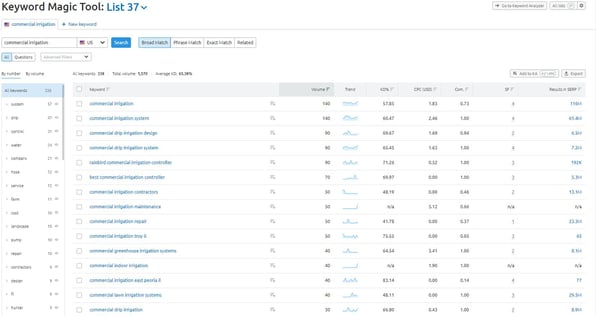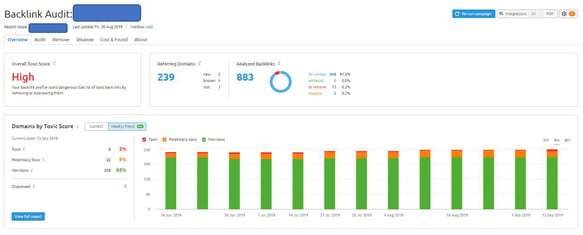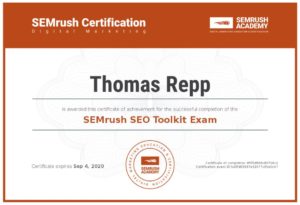
When it comes to lead generation, a quality web presence can optimize your industrial marketing dollars if you know about the online marketing trifecta.
What trifecta, do you ask?
Google’s free tools, HubSpot’s marketing automation platform and SEMrush’s online research data.
First, let explain what each component of this grand marketing trifecta is.
Google’s Free Tools for Marketers
Everyone knows what Google is, but most do not know how much data Google collects that can be of value to an industrial marketer. Google has two primary tools you can use as an industrial marketer:
Basically, Google Analytics gathers pre-click data. That is, before a web user clicks anything on your web page, such as, impressions & position tracking. Google Search Console (GSC) gathers post-click data. Post-click data provides metrics such as bounce rate and completion of goals you set up in GSC.
Google Analytics allows you to add a piece of code to each webpage and then drill down to critical data such as:
- Find out which campaigns bring the most traffic and best conversions
- Determine where your best visitors are located
- Learn what search terms bring people to your site
- A graphic that helps you visualize what people click the most on each page
- Which of your Pulitzer Prize-winning e-books gets the most love from your audience?
- Identify which pages you might want to get rid of
- And more…
Google Search Console is a suite of tools, provided on one dashboard.
From a technical aspect GSC can tell you just about everything a marketer needs to know. For example:
- Technically, GSC ensures you have crossed all the “t’s” and dotted all the “i’s” on each web page
- Remove content that you don’t want shown…possibly for reputation management
- Monitor and fix malware that always creeps into websites
- Which search queries produce the best search results in the SERPs (Search Engine Return Pages)?
- Which sites linking into your website are hurting rankings and which are helping?
- Is your website performing as it should for mobile platforms…a very big deal in today’s mobile society?
- And more….
Here is the challenge for a marketer using the Google marketing platform and tools.
They only help you monitor your own website. Google Analytics and Google Search Console tells you little about your industrial competitors.
This is where SEMrush comes in:
According to SEMrush’s website, “SEMrush is an online market intelligence and competitive research platform that provides estimations of any website’s desktop and mobile traffic. It can help you spot your rival’s strength and weaknesses, evaluate a new market or niche, and even build a successful media buying strategy.”
If you want, read a review of SEMrush from PCMag to review the many tools SEMrush offers.
SEMrush has over 30 tools, has indexed over 8 billion keywords has over 8 trillion backlinks and 143 geo databases that provide data to their many research tools.
So…let’s get real. How does all this data help you?
I will tell you exactly how I use SEMrush and highlight the strategies and specific tools I am using for a regional industrial supplier. These are strategies and tools that would work for any good size regional or national industrial supply or service company.
Let me first start with my top-level strategy. Each tools’ capabilities & benefits flow from my top-level strategy.
As I have written often, there is a lack of online marketing know-how in the industrial sector. Specifically, industrial marketers are very poor at publishing great content for their prospects & customers…as now required by Google. (I will show you in paragraph below about SEMrush’s Position Tracking Tool and prove this statement to be true)
To take advantage of this large opening for savvy industrial marketers, I have focused on three specific areas that I can exploit for the benefit of my industrial client.
- A lack of quality content, especially for specific technical niches
- Google’s Featured Snippet feature is not well known and not used at all in the industrial sector.
- Quality or authoritative backlinks (links into your website) is one of the most powerful of all ranking factors for Google. Again, industrial marketers are not using this tactic at all.
SEMrush not only proves to me the statements above are true, the SEMrush tools help me fine tune my strategy and tactics to optimize content on my client’s website and take advantage of competitors’ lack of online market savvy.
For example, my client has selected a specific number of key topics that he would like to be ranked for on Google’s first page. These topics are not selected by any online research tool, but products and services that are current or potential profit centers for my client. Some would call these niche services or low-hanging fruit.
I call them money-makers.
So…to feature these critical topics we are building pillar pages with topic clusters for my client’s website. According to HubSpot a pillar page is, “the basis on which a topic cluster is built. A pillar page covers all aspects of the topic on a single page, with room for more in-depth reporting in the more detailed cluster blog posts that hyperlink back to the pillar page.”
To simplify, in the graphic below the circle in the middle is the pillar page and the related sub-topics are then linked to the pillar page. In other words, most people (64%) now use four words or more in their search queries. Moving forward, we are seeing a growing number of longer more semantic searches, such as, “OK Google, tell me where the closest supplier of commercial Rain Bird products is?” And…of course, this is often done on a mobile device using voice recognition.

By giving Google what they want…more information…using the pillar page & topic cluster you are telling Google, “Hey…Google, we really know lawn sprinklers. We are a commercial supplier. We have been in business for 30 years. We carry commercial Rain Bird sprinkler components and we are located in Plano,Texas.”
If your company’s pillar page contains valuable information about “the difference between residential and commercial Rain Bird products” and contain outbound links to Rain Bird’s web site and additional information about commercial irrigation projects, then Google knows to place you at the top of the search engine return page. Based on your mobile device’s location, Google can also tell a web-user where the closest supplier is as long as you met Google’s specific requirements for geo-targeting. Platforms such as SEMrush give you a “heads up” when you fail to give the data to Google in the proper format. Again, if you build your website in this manor you are all set for voice search.
Using SEMrush gives me the following information to optimize this strategy.
- Keywords Gap Tool: SEMrush’s Keyword Gap report tells which competitors’ rank for specific keywords or topics and where my client does not. This gives us valuable insights into the next topics we should focus on and then publish.
- Keyword Magic Tool: SEMrush’s Keyword Magic Tool is awesome. I can plug in the primary or “seed” keyword into the tool and SEMrush provides me with sub-topics I can publish to enhance the pillar pages’ effectiveness. I know the volume of the keywords/topics, I know the difficulty of each keywords/topic, I know what each keywords/topic will cost me if I used paid search, etc…all valuable information when making decisions about the next blog or e-book we need to publish. Even though I know the industry well and in constant contact with the owner, I’m still amazed at the trending topics that pop-up neither of us had thought of.

- SEO Content Template: SEMrush’s SEO Content Template tool helps us design SEO-friendly pieces of content. It also helps us find backlinks into our webpages that have the most authority with Google. HubSpot and other marketing automation platforms provide some of this information, but SEMrush does so much more. For example, the platform even gives us email addresses of contacts and keeps track of your efforts to gather those valuable backlinks. Did they respond to our requests? Do we need to contact them again? Did they post something on their website that links to our site and did they link to the page you requested.
- Backlink Audit Tool: Beside providing valuable “Google Juice”, backlinks can be very toxic to your website as well. In checking with my client’s site which was built on the HubSpot’s content management & marketing automation platform a couple years ago I found some dangerous backlinks that need to be taken care of. In this report you can see 8 “toxic” pages, 9 “potentially toxic” pages and the rest are just fine. The Backlink Audit Tool makes it easy to export a list of toxic links to Google Search Console, so Google can disavow the links and remove any potential harm.

- Content Analyzer Tool: SEMrush’s Content Analyzer Tool helps measure the effectiveness of each piece of content, not only on our own site but articles, blog posts, graphic logos, etc. placed on external sites. Are efforts to create engaging content working? Again, marketing automation platforms, like HubSpot, give you good data on the content on your site, but fail to help you understand your external efforts like SEMrush does.
- Position Tracking Tool: SEMrush’s Position Tracking Tool allows you to monitor your keywords as well as your competitors. Position Tracking Tool allows me to track keyword positions by region, again a capability that most marketing automation platforms do not. This is particularly important for regional suppliers. You can easily set up notifications when your targeted or selected keywords make large moves, up or down, in the SERPs. Given our goal of reaching Featured Snippet status, the Position Tracking Tool also tells me which websites have a Featured Snippet on the SERP. From that information we can mimic what has worked and go one better. The Featured Snippet Tool also makes it easy to monitor our progress to see which topics have gather Featured Snippet status and which ones need more work. This tool also tells what kind of traffic we can expect once we do reach Featured Snippet status. Again, these are capabilities not available within HubSpot and other marketing automation platforms.
![]()
This graphic demonstrates the lack of content for industrial marketers. In this graphic SEMrush provides data for 30 critical topics that I have entered manually into SEMrush on behalf of my client. These are topics my client wishes to be an online thought-leader for. Having top positions will help branding & top-of-mind awareness. These are common topics that anyone in my client’s industry should rank well for. I have also entered 20 of my client’s competitors. I have included regional competitors as well national leaders. The national leaders, mostly public companies, are more likely to have the resources to do world-class online marketing. This graphic clearly demonstrates they have not invested in the competitive edge the marketing trifecta provides.
This graphic provides data for 6 key SERP features that you have all seen, but maybe not aware of. Moving left to right SEMrush shows featured snippets, local information provided to Google, how many online reviews, how many inbound links, how many videos & how many videos have been featured on other, external, websites.
As I said earlier, my goal for my client is get them to Featured Snippet status and improve backlinks. A secondary goal, to start publishing more videos on their website. We are currently working on 30 pillar pages, blogs to support these pillar pages (sub-topics) and more videos.
What the graphic clearly demonstrates is that my client, even before we upgrade their website with Featured Snippet status, more backlinks and more videos, is the only website out of 20 industry leaders taking advantage of these 6 key SERP features. The darker blue columns simply show that my client has filled Google’s requirements for local information and that they are the only one of 20 competitors that have any authoritative backlinks that Google recognizes.
Now, the third component of the powerful marketing trifecta, HubSpot
If you read my blog often you know I am a big fan of HubSpot.
If an industrial company wants to get serious about lead generation and improve top-of-mind awareness they must publish great content for their audience and for Google to notice. Period.
The only way to publish great content (pillar pages, blog posts, e-books, videos, product sheets, etc.) efficiently is to deploy your content using marketing automation and HubSpot is the best choice for small to mid-size industrial companies. This will involve a subscription and you can see the pricing right here. If you want, you can start with a free CRM package. It is unlimited and you will never be charged for the service. I use it and it is excellent.
Once all your trifecta components are tied together (including integration of Google’s tools with HubSpot & SEMrush) you will have a competitive advantage that few have in the industrial sector…at least for now.
I’m sure for the industrial marketer that would like to achieve better results from online marketing efforts, these tools can be intimidating. Sure…anything like this takes time, resources and expertise. However, Google and SEMrush have excellent tutorials and videos to learn from. HubSpot, on the other hand, has some of the best training in the world, as well as world-class customer support.
It is a long road indeed, but I believe the industrial companies that embrace these industrial marketing tools & tactics will end up at the top of the heap and stay there for some time…because I simply don’t see the small to mid-size industrial community embracing these principles as they should.
If anyone doubts me, I will be glad to share with you what I see. SEMrush makes it easy to see what your competitors are doing. Give me your top 10 competitors and I will easily demonstrate the gaping hole your friends in the industrial community have left for you.
Can you say, “Opportunity”?
For more info on what The Repp Group can do for your industrial marketing & lead generation…CLICK BELOW
Author:Tom Repp
A passionate marketer attempting to change the way industrial marketers leverage the web as a growth-oriented, lead generation machine. View all posts by Tom Repp



